Planting indoor grapes and care at home
Indoor grapes, cissus, grape ivy, birch - the names of perennial weaving liana. The culture grows rapidly, clinging to the support with antennae, rarely blooms indoors, but is not devoid of decorativeness. The attention of flower growers is attracted by different types of cissus: Antarctic, rhombic, two-color, quadrangular, caudex. In this article, we will talk about indoor grapes and caring for them at home.
The content of the article
Decorative indoor grapes
Cissus (gr. Kissos - ivy) is a perennial deciduous liana with weaving shootsreaching 5 m in length. The plant belongs to the grape family. The genus includes about 350 forms. These are mainly wild plants. Other names for the culture are indoor grapes, birch.
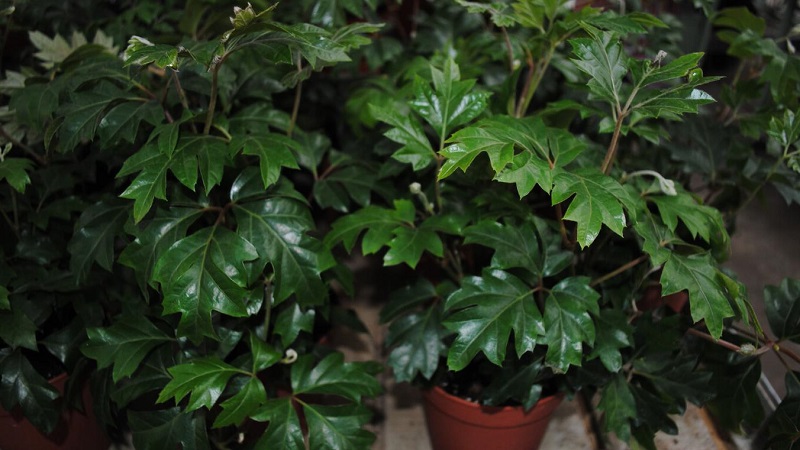
The plant is tall, the vines cling to the support with antennae. The shape of the leaves is varied, depending on the variety and type of grape. The leaf plate can be ternary and solid. Often the shape is jagged, resembling a leaf blade of wild grapes.
Indoors, the plant blooms rarely or never.... Cissus flowers are small, green, collected in expressionless inflorescences. The homeland of indoor grapes is Asia, America, Australia. There, the culture is found in subtropical and tropical forests.
Reference. Indoor grapes are grown in apartments because of their ability to purify the air and ease of maintenance.
The stems and shoots of cissus are fragile, therefore it is recommended to determine a permanent place before planting for him, so as not to transfer the pot to another room in the future.
Types of home grapes
In addition to cissus, there is another indoor grape called tetrastigma.... However, it is not popular with flower growers because of its overweight liana. The culture is most often grown in gardens and greenhouses. In natural conditions, the liana reaches 50 m in height. It is decorated with large, lobed leaves and small, unremarkable flowers. At home, tetrastigma is shortened to 2-3 m. For a year, the vine is extended by 1 m in height.
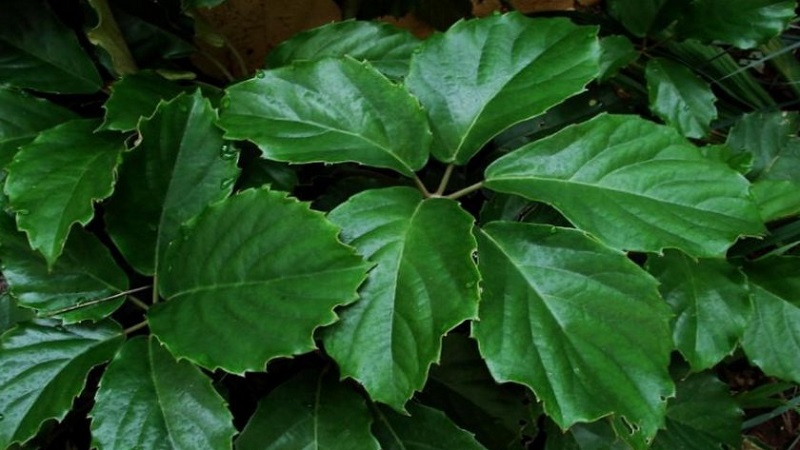
Cissus is more popular among florists.... It is grown in apartments, private houses, offices and conservatories.
Exist several cultivated species of this plant:
- Antarctic (C. antarctica). "Liana-kangaroo", or arctic cissus, has oval leaves up to 10 cm in length. It is used for landscaping offices, schools and other institutions. Differs in unpretentiousness and is not afraid of temperature fluctuations.
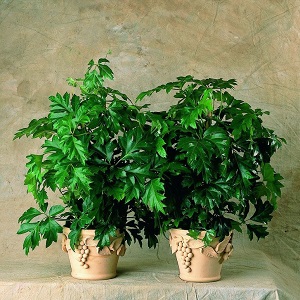 Diamond-shaped (C. rhombifolia) is one of the most popular types in home floriculture. The greens are dense, fluffy, the leaf blade is diamond-shaped, glossy, of medium size. The height of the vine is 1.5 m. The shoots are elastic, with a brownish edge. This form is represented by Fionia with a carved leaf plate and Helen Danica with carved leaves. The Mandiana variety has leathery, dense, shiny leaves with short villi, brown-red shoots. It copes with temperature changes more easily than others.
Diamond-shaped (C. rhombifolia) is one of the most popular types in home floriculture. The greens are dense, fluffy, the leaf blade is diamond-shaped, glossy, of medium size. The height of the vine is 1.5 m. The shoots are elastic, with a brownish edge. This form is represented by Fionia with a carved leaf plate and Helen Danica with carved leaves. The Mandiana variety has leathery, dense, shiny leaves with short villi, brown-red shoots. It copes with temperature changes more easily than others.- Bicolor (C. discolor, discolor or multicolored cissus) - the most capricious. Requires strict adherence to growing conditions. The leaves are dark green with a silver pattern, the back is maroon.
- Quadrangular (C. quadrangularis) - a plant with unusual three-lobed leaves, thick tetrahedral shoots. Less common among indoor crops, because it grows slowly.
- Striped (C.striata) is distinguished by small, three- or five-fingered leaves that resemble maiden grapes. The plant is characterized by high growth, undemanding to temperature and humidity.
- Caudex (C. tuberosa, tuberose). The trunk is bottle-shaped, long stems, with aerial roots. The leaves resemble maple leaves.
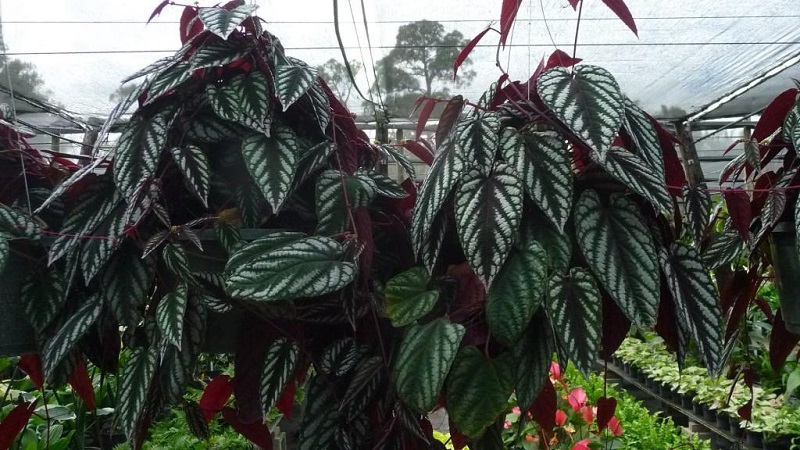
Planting indoor grapes
A place for planting cissus is chosen in the east or west side of the house without drafts... The optimum air temperature should be + 22 ... + 25 ° С in the warm season and + 18 ... + 20 ° С - in winter. Small bushes are taken out on the balcony in summer. Two-tone citrus does not like temperature changes, so a comfortable place is immediately determined for it.
Indoor grapes prefer diffused lighting, therefore, it is better not to put it next to windows. The ideal place for a plant is a niche in the walls of the room, where sunlight gets in, but not direct rays. The room should not be too dry, since the lack of moisture is detrimental to the plant. Arctic cissus is undemanding to lighting and can grow even in dark corridors.
Interesting on the site:
Landing rules
Cissus is propagated by cuttings:
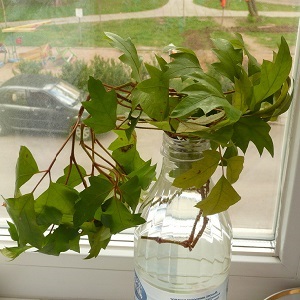 From a biennial plant, the upper shoots with 2 buds are cut off.
From a biennial plant, the upper shoots with 2 buds are cut off.- The cuttings are placed in clean water at room temperature and wait for the roots to appear or immediately placed in a loose substrate.
- After the roots appear, the plant is transplanted into a large pot. Several cuttings are planted in one container. Its volume should be enough for 5 years, since it is with this frequency that it is recommended to transplant cissus.
For planting, a soil mixture is prepared from turf, leafy earth, peat, humus and sand in equal proportions. The acidity of the soil is neutral or slightly acidic (pH = 5.5–6). The optimum temperature for germination of cuttings is + 22 ... + 23 ° С.
Expanded clay is poured at the bottom of the pot to prevent stagnation of water. The container is filled with a prepared moist substrate, a 4-5 cm depression is made and the cutting is carefully placed. The hole is covered with soil, without compaction, and watered with water.
Cissus care at home
Homemade grapes are easy to care for... It is important to follow the rules for watering, feeding and pruning.
Watering
Most species are highly vigorous, so they need regular watering... The active period of growth occurs in the spring - summer. For irrigation, use clean, settled water at room temperature. The plant is watered as the top layer of the soil dries up, avoiding overflow.
Reference. Every six months, indoor grapes are sprinkled. It refreshes the leaves, removes dust from them, makes the color bright and juicy, helps to avoid the appearance of pests and diseases.
Waterlogging leads to the appearance of root rot... To test the soil for moisture, just dip your finger into it. If the earth sticks, there is enough moisture, if the finger is dry, watering is required. Closer to winter, the amount of irrigation is reduced to 1 time in 7-10 days.
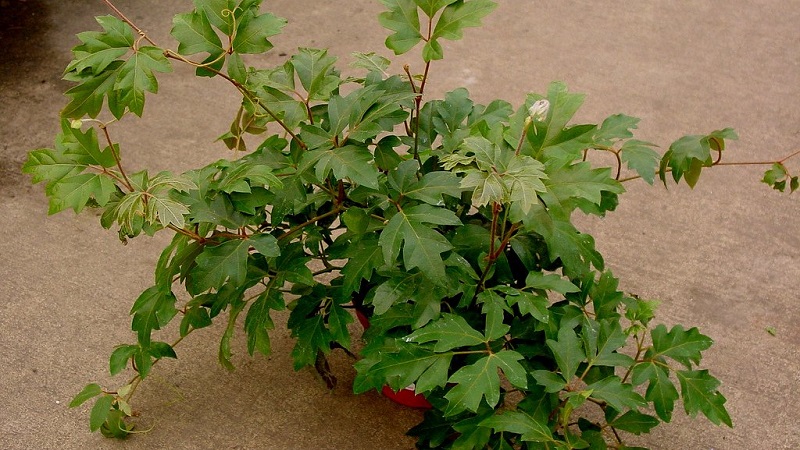
Top dressing
Fertilizers for non-flowering plants are used to feed indoor grapes.: succinic acid, Bona Forte, Ideal, Florist, Mister Color, Success, Agricola. Substances are added once every 14 days. In spring, cissus is fertilized with nitrogen, in autumn - with potassium-phosphorus agents. In winter, no top dressing is added.
As the bush develops, young shoots are pinched and pruned... This allows you to regulate the growth of the crop in width and height, to give the desired shape. Pruning is carried out in the spring, trying not to break fragile shoots. To make the plant less branching, pinch the tops.
Read also:
How to grow indoor pomegranate
Transfer
 The first transplant is carried out 5 years after planting... To do this, use a larger pot and change the old substrate to a fresh one.The composition of the soil is the same as when planting. After the procedure, the upper stems of the bush are cut, this stimulates the formation of lateral shoots.
The first transplant is carried out 5 years after planting... To do this, use a larger pot and change the old substrate to a fresh one.The composition of the soil is the same as when planting. After the procedure, the upper stems of the bush are cut, this stimulates the formation of lateral shoots.
In the future, cissus is transplanted as it grows. Often the procedure is performed annually for 5 years, then once every 2-3 years.
Transplant in the spring, make nitrogen fertilizing for fast rooting and adaptation of the plant to fresh soil.
Possible problems
Most problems with cissus occur when the rules of care are violated.
Table 1 summarizes the main diseases of culture and methods of treatment.
| Name | Symptoms | Treatment |
| Powdery mildew | White bloom on petioles and leaves. | "Fitosporin", "Alirin-B", "Chistotsvet", "Tiovit Jet", "Topaz". |
| Corner spot | Yellowish-brown translucent spots with clear contours. | Removal of diseased leaves, treatment with a solution of copper oxychloride or Bordeaux liquid. |
| Root rot | Loss of gloss and yellowing of foliage, softening of the root collar, rotting of the roots. | Removal of damaged roots, yellow leaves, support of the regime of abundant, but rare watering, the use of "Fitosporin" solution. |
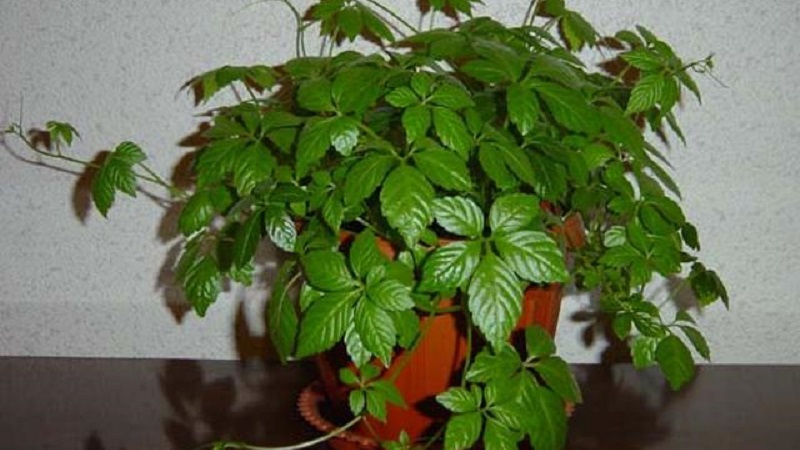
Table 2 summarizes the main pests and methods of controlling them..
| Name | Symptoms | Treatment |
| Spider mite | White blotches on leaves, dry areas, cobweb. | "Lightning", "Akarin", "Fitoverm". |
| Multi-claw mite | Stopping the growth of the upper leaves and twisting of young, brown growths on the petioles. | Fitoverm, Vertimek. |
| Aphid | Insect colonies on leaves, yellowing, sticky coating. | Removal of contaminated areas, treatment with soapy water (50 g of laundry soap per 3 liters of water), "Antitlin", "Aktellik", "Iskra". |
Possible problems:
- Yellowing of leaves due to lack of moisture or watering with hard water, lack of nutrients in the soil or excess calcium.
- Pale leaves due to too bright light.
- Brown leaf tips due to too dry air, lack of moisture, exposure to cold air, or touching a cold window in winter.
- Brown spots on foliage due to a sharp drop in air temperature, excess moisture, watering with hard water.
- Dry leaves due to excessive heat and dry air, lack of moisture or overflow and stagnation of water in the pot.
Conclusion
Cissus grape is a houseplant for decorating balconies, walls and niches. It is unpretentious in care, but for proper growth and development it needs to create favorable conditions in the room. The plant prefers diffused light, humid air and frequent watering.
To maintain health, the bushes are fed with organics and minerals, every six months they arrange sprinkling to wash off particles of dust and insects. Popular types of cissus: Antarctic, rhomboid, bicolor, quadrangular, caudex.